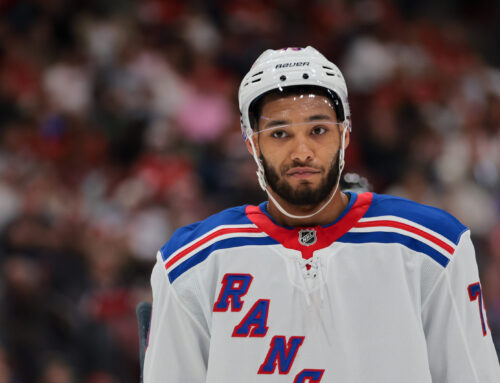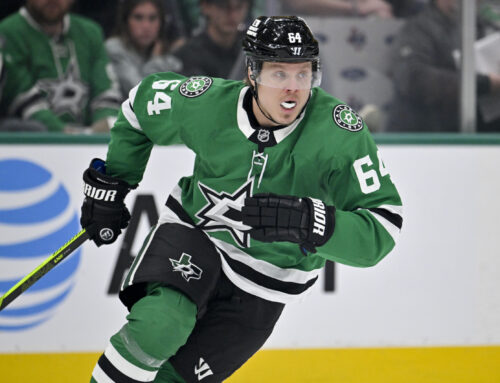In last week’s column, we focused on players who saw a significant decrease in shooting percentage this season. This week, we’re going to look at players who saw a substantial boost in shooting percentage.
As a quick refresher, a player who takes 200 shots a season (just under 2.5 shots per game) and has an increase of five percentage points will score an extra 10 goals. Three hundred shots and an increase of six percentage points equals 18 more goals. This is enough to turn potential busts into keepers.
Usually, a higher-than-average shooting percentage should be a red flag going into next season. A veteran player who usually scores on eight per cent of his shots all of a sudden scoring on 14 per cent can sometimes be one great year to be followed by a regression next season. However, for younger players, a notable increase in shooting percentage could be the start of a great run of seasons.
Below are 10 players who saw noteworthy increases in shooting percentage this season.
10. Brock Nelson
Teammate Justin Bailey could have been in this spot, but he doesn’t shoot enough to be fantasy relevant. Instead, Nelson deserves recognition after scoring 37 goals, smashing his previous high of 26. His 2.4 shots per game are on pace with what he’s done the last few years, but his 21.6 per cent shooting is easily a career high. He came into the season averaging 14.3 per cent in his previous four seasons and 13.2 per cent in his career. That’s a difference of about 12-14 goals this season compared to what he usually would have potted.
9. Dylan Strome
Strome has always had a high shooting percentage (he shot 12.4 per cent in his worst season), but he doesn’t shoot often enough to be considered a goal scorer. He has yet to reach two shots per game in any season. This year, he averaged 1.8 shots per game, but his shooting percentage of 17.5 per cent was a career high, up from 12.7 per cent last year and a career average of 12.9 per cent. This led to 22 goals in 69 games for Strome, who is a restricted free agent but is rumoured to be on the trading block.
Keller would have posted his first 30-goal season if he had stayed healthy, and might have reached 35 goals if everything went perfect. Instead, he finished with 28 goals in 67 games thanks to a career-high 15.8 per cent shooting. His previous high was 11.3 per cent last year, and his career average before this season was 9.4 per cent. Since he shot seven per cent in 2017-18, he has improved his shooting percentage in each season, so this could be a new normal for Keller.
Many times, a player who sees a skyrocketing increase in shooting percentage can often be written off as simply playing with elite linemates. That may seem to be the case for Duclair at first glance, but it’s not that simple. A year ago, he played mainly with Aleksander Barkov and Jonathan Huberdeau, but scored on only 9.6 per cent of his shots. This year, Duclair continued to play that top-six role with those two, but shot 18.6 per cent. That’s an obscene increase. A small factor is the power play, where he scored nine goals on 42 shots (a shooting percentage of 21.4 per cent), but he still scored 22 goals on 125 shots (17.6 per cent) at even strength.
Despite 11 years in the league, Landeskog just notched his second 30-goal season this year. A big chunk of that reasoning is because he’s often injured, but a sky-high shooting percentage helped immensely. His previous career high for shooting percentage was 14.5 per cent, and his career average was 11.6 per cent. This year, that shooting percentage jumped to an even 20 per cent. He is still averaging just under three shots per game, but he probably won’t be able to keep up the shooting percentage or the healthiness.
Safe to say that Danault’s first season in L.A. was a huge success. A year ago, he was seen as a great shut-down centreman who couldn’t score. Then he signed a five-year contract with the Kings and scored 27 goals. That is slightly more than double his previous high of 13. Part of that increase in goals is related to shots on goal. He averaged 2.5 shots per night, up from 1.4 last year and better than his previous high of 1.8. His shooting percentage was also up to 13.9 per cent, double last season’s 6.8 per cent and the first time he’s ever cracked 10 per cent. In his six years with the Habs, he averaged a 9.2 shooting percentage.
4. Dylan Larkin
Larkin has been hit and miss as a goal-scorer, but this year saw him reach 30 goals for the second time in his seven-year career. While he’s mostly been consistent with shot rates (he’s ranged from 2.8 shots per game to 3.1 shots per game in six seasons), his shooting percentage has usually been too low. He’s been at 8.5 per cent or lower in three of his last four campaigns and averaged 9.1 per cent for his career before this season. This year, that shooting percentage jumped to 14.6 per cent, besting his previous high by 3.5 percentage points and only the third time he’s been above 10 per cent. Shooting his average this year would have left him with 19 goals instead of 31.
Johansen has been mostly disappointing since leaving Columbus. The Preds were hoping they were getting a 30-goal, 70-point player as he was doing with the Blue Jackets. Instead, they got a player who maxed out at 15 goals and 64 points. In his first five full seasons with Nashville, he averaged a shooting percentage of 10.9 per cent, but averaged only 1.64 shots per game. His shot rate was still low this year (1.5 shots per game), but his shooting percentage skyrocketed to 22 per cent. That brought his goal total up to 26 this year. He’s probably the biggest buyer beware in this column as it is tough to believe that he can score at a high level while taking so few shots.
Thompson was quickly on his way to being considered a bust. In his first four years, he played 145 games and scored 18 goals. During that time, his shooting percentage was 6.9 per cent while he averaged 1.79 shots per game. This season, his shooting percentage skyrocketed to 15 per cent. It also helps that he averaged 3.2 shots per game. Even with the increase in shots, if he had finished the season matching his career shooting percentage, he would have scored 17 goals instead of 38.
1. Jack Hughes
Hughes is about to become elite, so it won’t be a surprise if he continues scoring on a high percentage of shots for the next decade. However, this year’s increase still deserves a mention. He shot 5.7 per cent as a rookie and 7.7 per cent in his sophomore season. This year, that number jumped to 15.8 per cent. Throw in a steady increase in shots taken (up to 3.4 shots per game this season), and he finished with 26 goals in 49 games.





 UTA
UTA MTL
MTL BUF
BUF MIN
MIN FLA
FLA VAN
VAN
 WSH
WSH OTT
OTT
